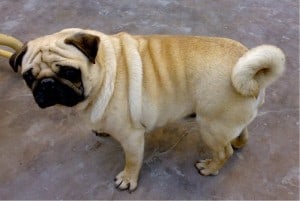Good day and welcome everyone!
This is Sharda with another Pugs newsletter.
Here we go!
Today we will have a closer look at the different Pug colors, you may find lovable and adorable.
Time and time again, you hear of a new owner disappointed with the coat colour of his darling Pug:
What was thought to be a “rare silver Pug” turns out to be a dark, ordinary one—and that’s neither rare nor standard.
Officially, however, the Pug comes in only two recognized colours—fawn and black.
We now learn that there are various shades of blacks and different types of fawns, and it’s easy to understand the differences.
It’s easy to accept that no two dogs are ever alike.
This is why you commonly find variations of black and fawn within the breed, which only ends up confusing the not-so-knowledgeable buyer.
This is how descriptions such as “apricot fawn” and “silver fawn” come about.
Black Pugs: There are two kinds of black Pugs—one that appears blue-black in the sun and is therefore called the blue-black Pug. Its highlights or tints shine with a blue shade instead of red. This colour of Pug is in complete conformity with the standard.
The second shade of black is a blend of rust and black—one that fades or tans in the harsh sun and develops into a rusty black. The texture of his coat is softer than the blue-black.
Fawn Pugs: Pugs of this shade should ideally have a bold black pigment on the mask, ears, eye rims and toenails. The coat should really be clear or without a heavy layer of dark black guard hairs or stiff outer hairs on the coat.
You will find that the Pug’s black mask, fawn coat and facial hairs set him apart, revealing a fine defining line between them. Therefore, there is no smudging of colours or one shade running into the other.
An apricot fawn is a fairly rare variation of the breed whose colour is eye-catching, pleasant and warm. This is easily distinguishable from other fawn colours as the darker ones are more orange than apricot in colour.
The rare silver Pug: Though these dogs have been around, they are the truly rare ones of this breed. Silver Pugs are those that do not have any black hair on their bodies.
Unscrupulous breeders may try to pass off Pugs with unknown colours to you, claiming they are rare silvers, so be careful!
Brindle Pugs: Brindle coloured Pugs are very popular now but are the result of crossbreeding a Pug with other breeds. The resulting Pugs are brindles and those with “pinto” colours.
According to the genetics of colours in dogs, there is not gene to account for brindling in the Pug. Obviously then, this gene must have come from a breed that carries it—an idea that gives more shape to the notion of crossbreeding.
Many breeds carry this gene, for instance, the Boston terrier and the French bulldog. These breeds are the closest in body structure to the Pug, so it is likely that breeders have mated these breeds with their Pugs.
Dogs can and do have pups within a litter that are sired by different fathers. In such cases, it is difficult to determine the father without a DNA test of each puppy of that litter.
But with rapid strides in DNA research, it will be possible to determine if a dog is “pure Pug” or “Pug mixed with another breed.” Till then, it is better to be wary of this type of Pug.
When you come across the term “DNA tested” brindles, be wary because what really happens is that breeders have a cheek swab done that costs about $35 – $40. This only proves that the pup is the baby of his registered parents. Big deal!
Albinos: Albinism is a special genetic mutation that can occur within any breed of dog or any other animal. This type of genetic mutation is so well known among pug breeders that they have already documented it.
It is a recessive gene and only when two albinos mate can an albino be born.
An albino has a white coat, pink skin, pink nose and eye rims. This shade of pink points to the fact that there is a lack of pigmentation and is therefore the exact opposite of a dog with full and rich pigment.
If your Pug is an Albino, beware as he can sunburn easily.
I hope that you learned a lot from today’s pugs newsletter.
Thanks and I will be back for more
Warmly,
Sharda Baker

